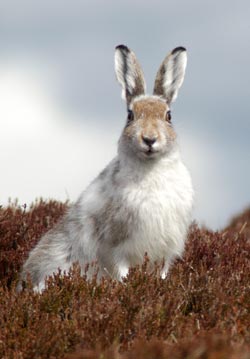 Project Contact
Project Contact
- Scott Newey (Macaulay Land Use Research Institute)
Project Summary
The Scottish mountain hare, Lepus timidus scoticus, is a subspecies of the mountain hare Lepus timidus and is native to the highlands of Scotland. Although widespread throughout Scotland, they are typically more numerous in central and eastern Scotland and are strongly associated with the heather moorland that is managed for red grouse - where they likely benefit from habitat management and predator control aimed at improving grouse densities.
Mountain hare populations on Scottish grouse moors can reach very high densities with up to 200 hares per square kilometre, and can show high amplitude regular fluctuations in density. Our research - based on the analysis of hunting records of the number of hares killed each year on individual sporting estates - suggests that around 50% of mountain hare populations are cyclic and show regular changes in density every 5-15 years. The reasons for these regular fluctuations remain unclear.
Mountain hare populations are under threat from habitat loss, fragmentation, and local over-exploitation and are thought to have declined in numbers and range in Great Britain. Long-term climate change is likely to adversely influence the sub-arctic/alpine habitats favoured by mountain hares. Mountain hares are listed in Annex V of the EC Habitats Directive (1992), as a species 'of community interest whose taking in the wild and exploitation may be subject to management measures'. Member States are therefore required to ensure the conservation status of mountain hares is maintained and that their populations are managed sustainably, and hares have recently been designated a UK Biodiversity Action Plan Species.
There are three broad questions our research on mountain hares is trying to address:
- What affect do intestinal parasites and food availability have on mountain hare population dynamics?
- How do mountain hare populations respond to different management regimes?
- How are mountain hare populations linked in space, and which and how far do individual hares move?
Associated Research
In a series of collaborative projects with The Game and Wildlife Conservation Trust, Scottish Natural Heritage, and other stake holders the Macaulay Land Use Research Institute has been investigating the conservation status and management of mountain hares.
- The conservation status and management of mountain hares
- The distribution of Mountain Hares in Scotland
- Estimating Mountain Hare numbers
Selected Publications & Reports
Dissecting the drivers of population cycles: interactions between parasites and mountain hare demography., Townsend, S.E.; Newey, S.J.; Thirgood, S.J.; Haydon, D.T., (2011) Ecological Modelling, 222, 48-56.
Population and individual level effects of over-winter supplementary feeding mountain hares., Newey, S.; Allison, P.; Thirgood, S.; Smith, A.A.; Graham, I.M., (2010) Journal of Zoology , 282, 214-220.
Distribution of mountain hares (Lepus timidus) in Scotland: results from a questionnaire., Patton, V.; Ewald, J.; Smith, A.A.; Newey, S.; Iason, G.; Thirgood, S.J.; Raynor, R., (2010) Mammal Review, 40, 313-326.
Culling wildlife hosts to control disease: mountain hares, red grouse and louping ill virus., Harrison, A.; Newey, S.; Gilbert, L.; Haydon, D.T.; Thirgood, S., (2010) Journal of Applied Ecology, 46, 926-930.
Using PIT tag technology to target supplementary feeding studies., Newey, S., Allison, P., Thirgood, S.J., Smith, A.A. and Graham, I.M. (2009) Wildlife Biology, 15, 405-411
Can parasites drive population cycles in mountain hares? , Townsend, S.E., Newey, S., Thirgood, S.J., Matthews, L., and Haydon, D.T. (2009) Proceedings of the Royal Society, Series B, 276:1611-1617.
The conservation status and management of mountain hares. , Newey, S., Iason, G.and Raynor, R. (2008). Scottish Natural Heritage Commissioned Report No.287 (ROAME No. F05AC316).
Do mountain hare populations cycle?, Newey, S., Willebrand, T., Haydon, D., Dahl, F., Aebischer, N., Smith, A. and Thirgood, S., (2007) Oikos, 116, 1547-1557.
Unstable dynamics and population regulation in mountain hares: a review., Newey, S., Dahl, F., Willebrand, T. and Thirgood, S., (2007) Biological Reviews, 82, 527-549.
Prevalence, intensity and aggregation of intestinal parasites in mountain hares and their potential impact on population dynamics., Newey, S., Shaw, D.J., Kirby, A., Montieth, P., Hudson, P.J., and Thirgood, S.J., (2005) International Journal for Parasitology, 35, 367-373.
Parasite-mediated reduction in fecundity of mountain hares. , Newey, S. and Thirgood, S.J., (2004) Proceedings of the Royal Society of London, Series B, 271(Suppl 6) S413-S415.
Can distance sampling and dung plots be used to assess the density of mountain hares Lepus timidus? , Newey, S., Bell, M., Enthoven, S. and Thirgood, S.J., (2003) Wildlife Biology, 9, 185-192.
See a full list of publications here, and read more about upland and wildlife research here.
|
Updated: 23 Jan 2024, Content by: SN
|

